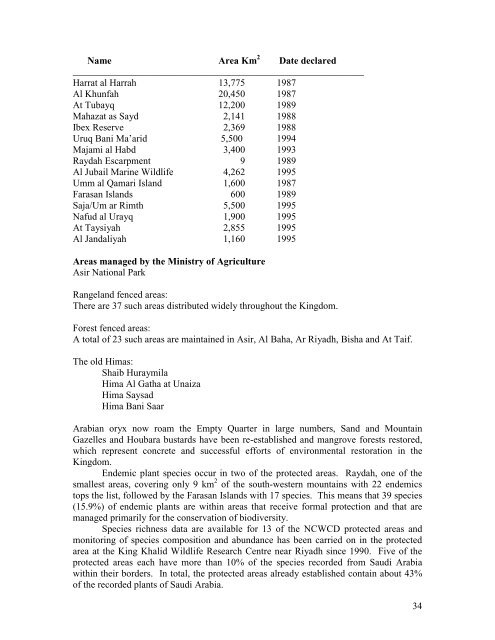Name Area Km 2 Date declared____________________________________________________________Harrat al Harrah 13,775 1987Al Khunfah 20,450 1987At Tubayq 12,200 1989Mahazat as Sayd 2,141 1988Ibex Reserve 2,369 1988Uruq Bani Ma’arid 5,500 1994Majami al Habd 3,400 1993Raydah Escarpment 9 1989Al Jubail Marine Wildlife 4,262 1995Umm al Qamari Island 1,600 1987Farasan Islands 600 1989Saja/Um ar Rimth 5,500 1995Nafud al Urayq 1,900 1995At Taysiyah 2,855 1995Al Jandaliyah 1,160 1995Areas managed by the Ministry of AgricultureAsir <strong>National</strong> ParkRangeland fenced areas:There are 37 such areas distributed widely throughout the Kingdom.Forest fenced areas:A total of 23 such areas are maintained in Asir, Al Baha, Ar Riyadh, Bisha and At Taif.The old Himas:Shaib HuraymilaHima Al Gatha at UnaizaHima SaysadHima Bani Saar<strong>Arabia</strong>n oryx now roam the Empty Quarter in large numbers, Sand and MountainGazelles and Houbara bustards have been re-established and mangrove forests restored,which represent concrete and successful efforts of environmental restoration in theKingdom.Endemic plant species occur in two of the protected areas. Raydah, one of thesmallest areas, covering only 9 km 2 of the south-western mountains with 22 endemicstops the list, followed by the Farasan Islands with 17 species. This means that 39 species(15.9%) of endemic plants are within areas that receive formal protection and that aremanaged primarily for the conservation of biodiversity.Species richness data are available for 13 of the NCWCD protected areas andmonitoring of species composition and abundance has been carried on in the protectedarea at the King Khalid Wildlife Research Centre near Riyadh since 1990. Five of theprotected areas each have more than 10% of the species recorded from <strong>Saudi</strong> <strong>Arabia</strong>within their borders. In total, the protected areas already established contain about 43%of the recorded plants of <strong>Saudi</strong> <strong>Arabia</strong>.34
3.2.5 AGRICULTURE AND RANGELANDSAgricultural practices and the state of the desert rangeland are particularly important tothe state of biodiversity in the Kingdom.Modern agricultural practices, especially widespread mechanical cultivation, useof chemical fertilizers and indiscriminate application of pesticides has dramaticallychanged natural habitats and reduced populations of wild animals, especiallyinvertebrates. There can be no question that modern <strong>Saudi</strong> <strong>Arabia</strong> needs increased outputfrom the farming sector of the economy. However, this needs to be done in ways that issustainable, which is currently not always the case.Use of saline water for cultivation is a particular problem in the Kingdom, sincemany boreholes produce highly saline water. Irrigation of the soils of many parts of theKingdom with salty water results in changes in soil structure and chemistry. Manyformer fields of wheat and barley as well as some of alfalfa have been turned in sabkhaswhere only halophytes will now grow. Not only has this reduced biodiversity, but alsoagricultural production has suffered.Many of the traditional himas as well as many terraces have been eitherabandoned or disappeared under fields that are suitable for mechanical cultivation. Insome cases, this has replaced sustainable systems of land use with ones that requireincreasing inputs of water and management to maintain their productivity, but is has alsomarkedly reduced the diversity of habitats.Desert rangeland, which includes dwarf-shrub steppes and arid grasslands, coverabout 1,700,00 km 2 (or about 76%) of <strong>Saudi</strong> <strong>Arabia</strong>. These areas would never have beenin a state of equilibrium in the true sense, since they are event-driven systems whose stateis determined largely by rainfall. Nonetheless, over-exploitation and disregard for theecological processes that drive such systems has resulted in catastrophic changes in thepast century.Although most of the plant communities of these areas have comparatively smallnumbers of species and many of these have very large distribution ranges, becauserangelands cover such a large area the total numbers of species found is high. Thegeneral aridity (average annual rainfall is less than 100 mm) and its erratic nature led tothe development of nomadic pastoralism to take advantage of the highly variableavailability of plants. Such traditional land use has persisted for centuries. Because theavailability of forage limited livestock numbers (which in turn, regulated humanpopulations), there was a dynamic equilibrium that checked serious environmentaldegradation.The introduction of water tankers, stock trucks, widespread water boreholes,supplementary feeds and veterinary services changed resource use in the rangelanddramatically. Increasing importance placed on education has discouraged families fromfollowing a nomadic lifestyle, leading to subtle but important sociological changes. Inaddition, the generally higher income levels has led many livestock owners to increasethe numbers of herds they own and employ herders to take care of these. Consequently,numbers of animals has dramatically increased and they stay in one place for longerperiods because water and feed are supplemented no matter what the rainfall. This hasresulted in livestock numbers increasing far above the natural carrying capacity of therangelands and has caused increased desertification, replacement of palatable shrubs andgrasses by unpalatable species and the extinction of species. As early as the 1970’s itwas estimated that 85% of <strong>Saudi</strong> <strong>Arabia</strong>’s rangelands were severely degraded and thesituation has certainly not improved since then.35
















